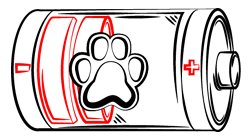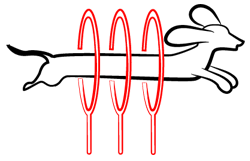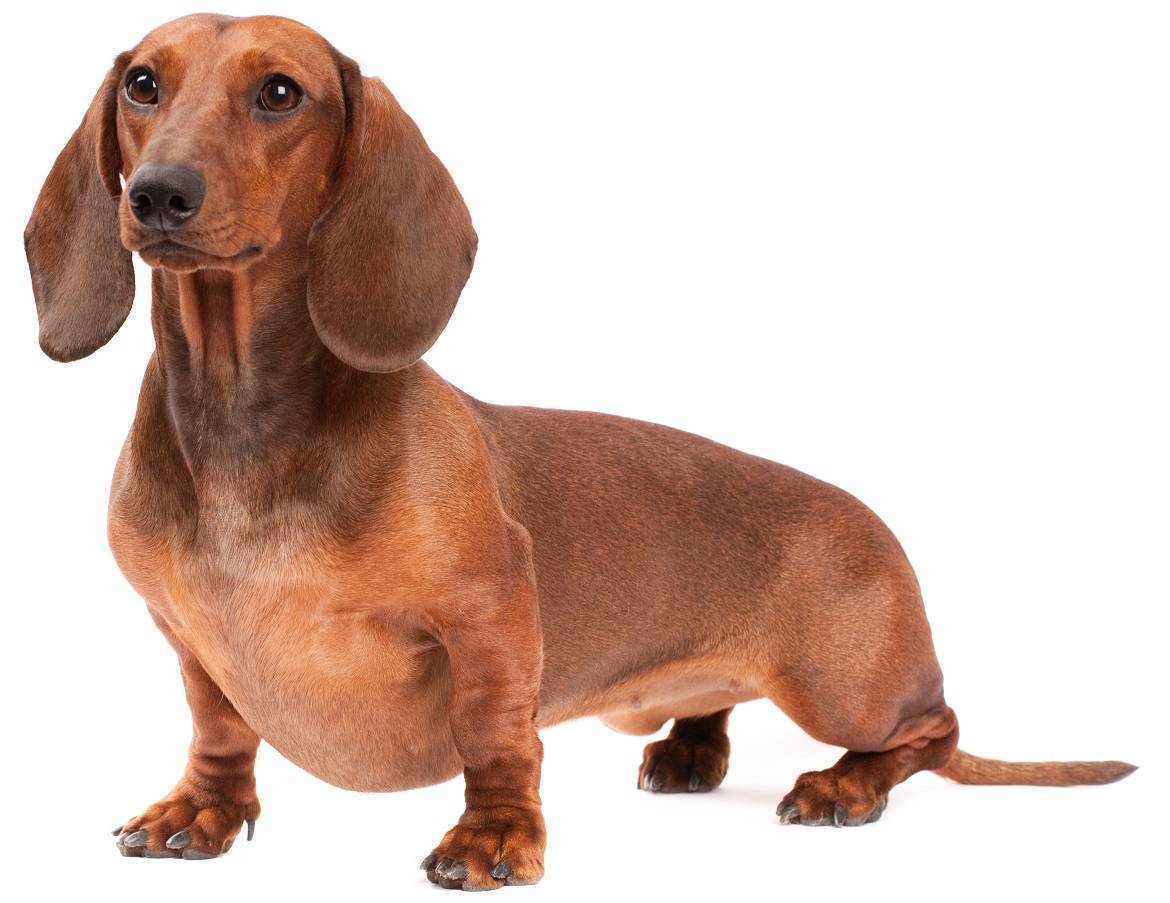
Paws ‘N’ Pups Quickview
Size
| Energy Level
| Trainability
| Paws ‘N’ Pups Rank
|
Characteristics
| Physical Characteristics: Height: Standard: 12-16” / Miniature: under 12” Weight: Standard: 16-33 lbs. / Miniature: under 12 lbs. Energy Level: Moderate | The American Kennel Club recognizes the Dachshund in 12 colors, all of which can be seen in brindle, dapple and sable. Coats are available in three types: smooth, wirehaired and longhaired. |
| Health & Longevity:14-17 years Breeders screen for the following conditions:
IVDD (Intervertebral Disc Disease), a disease in which a disc develops a problem and the material inside escapes into the spinal column, ultimately causing pain, nerve damage, and partial or complete paralysis. Back injuries are also common. Like many deep chested breeds, Dachshunds are susceptible to gastric torsion (bloat), a life-threatening situation if immediate veterinary intervention is not sought. Deafness is sometimes seen in dogs bred from double dapple parents. | |
Temperament & Train-ability
The lively and charming Dachshund has come a long way from their early days hunting badger. Although not originally bred as a companion, today’s Dachshund is a playful and devoted companion, being less tough than their ancestors and more likely to want to hunt out the most comfy spot for a nap. Still, many do carry a bit of “fire”, being prone to chase wildlife and possessing mouthy tendencies. These are scent hounds, and must be kept on leash when outdoors lest they follow some critter’s trail for miles. A secure yard is a must, and should be checked regularly for holes and evidence of digging. Digging is still a strong instinct in many Dachshunds, so it may behoove you to provide an area in your yard where your dog can satisfy this need. Naturally suspicious of strangers, your Dachshund will make a good watchdog. Generally speaking, Dachshunds get along with other dogs, but some can be possessive over prized toys and scrappy with other dogs.
Dachshunds are good options for apartment or condo dwellers and wonderful companions for seniors. They are a good choice for inexperienced novice dog owners. Long hours alone can result in excessive barking; these cuddlers want to be with their people and should never live outside. Dachshunds are sensitive to cold, so a coat or sweater may be needed. Exercise needs are easily satisfied; Dachshunds are generally active indoors and their playful nature makes it easy to exercise them inside with some fetch games. They also greatly enjoy walks, and a couple 10-15 minute walks usually satisfies their needs; a harness is recommended over attaching the leash to their collar. Caution must be used to keep your Dachshund from jumping off of furniture, as this can lead to back injuries common in the breed. Ramps and stairs can be purchased to allow your Dachshund to access furniture safely. It is also important when holding your Dachshund to fully support their back.
Dachshunds are usually good family dogs, often enjoying the company of children. However, because of their natural suspicion of strangers, your children’s friends may not receive the same welcome. Just as your dog will need careful socialization to learn appropriate behavior around children, your children must be taught how to properly interact with your Dachshund. Children should not be allowed to pick up a Dachshund, and always sit on the floor to hold a dog to avoid accidental drops or injury resulting from a dog jumping out of their arms. Never allow children to pull ears, poke eyes, etc. Children should be taught how to recognize when a dog needs a break and give them space. Dachshunds can be one-person dogs, so having the entire family involved in their care is recommended lest they become overly possessive and snappy over “their” person.
Temperaments between the coat types vary. The wirehairs are very terrier-like, spunky and tough, reflecting their terrier heritage. The longhairs are quiet and sweet from the spaniel influence. The original smooth coats are somewhere in the middle, but also the most likely to be a one-person dog and the most aloof with strangers.
Possessing some terrier-like qualities, Dachshunds can be stubborn. However, using positive reinforcement methods will minimize the amount of frustration and greatly increase your success in training your dog. Using forceful methods with a Dachshund is likely to cause them to push back, a completely unnecessary situation, as they are intelligent dogs. Make training fun and interesting for them; use a variety of rewards, sometimes food, and sometimes toys. Indeed, many Dachshunds are successful in a variety of dog sports; obedience, field trials, barn hunt, and earthdog. Some enjoy work as therapy dogs. Your Dachshund will need early and ongoing socialization to avoid excessive suspiciousness of strangers.
House training can be a challenge, and some Dachshunds don’t like inclement weather. Many owners opt for an indoor potty option for their dogs, such as pee pads or another type of potty tray. This ensures an acceptable location for the dog to relieve itself is always close by, reducing the likelihood of accidents in unwanted places. A covered outdoor area is another option.
Grooming
The darling Dachshund is available in three coat types: smooth, longhaired, and wire haired. Care is similar, although the longhaired and wire coated varieties will need more brushing, respectively. The longhaired Dachshund will need daily brushing of the furnishings to keep mats from developing in the soft hair, particularly behind the ears and on the backs of the legs. The wirehair will need brushing twice a week or so, and the smooth weekly brushing with a curry or soft bristle brush. Dachshunds don’t shed an inordinate amount, but will go through heavier sheds twice a year, in spring and fall.
Ears must be cleaned regularly, and toenails should be trimmed; even if your Dachshund wears their nails down, you will want to maintain the ability to handle their feet, especially useful as they age, when wear to the nails typically slows down. Teeth must also be checked and cleaned regularly.
Diet
The amount of food a Dachshund will require can vary depending on age, activity level, and type of food fed. On average, they will eat 1/2 – 1 1/2 cups of food daily, fed in two meals. Dachshunds are prone to weight gain, which is very bad for their backs; free feeding should be avoided. A high quality food should be fed. A constant supply of fresh, clean water must always be available.
Looking for a Dachsund?
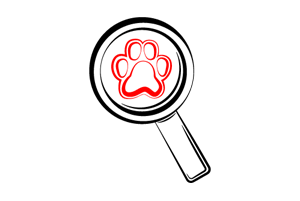 Find A Dachshund Breeder | 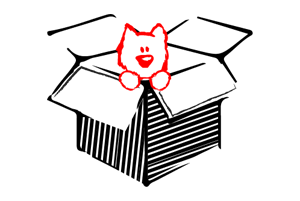 Dachshund Puppies For Sale | 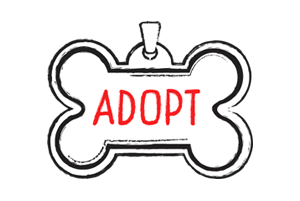 Adopt A Dachshund |
Cost
The cost for a Dachshund is in the $600-$1,200 range. Dachshund breed rescue organizations are quite active, taking in dogs that have lost their homes and working to find them new families. Adoption fees generally range $300-$600. Whether you acquire a dog from a breeder or rescue, do your homework to be assured that the temperaments of the dogs are tested and sound. Ongoing expenditures include the typical supplies, food, and regular vet visits.
Paws ‘N’ Pups Ranking
Paws ‘N’ Pups ranks every breed out of 4 with 1 being easiest to integrate into your life and 4 being the toughest – The lower the ranking the better.
Ranking takes into account a few basic factors such as cost, skill level needed, high vs. low maintenance, and how critical regular training is to success.
The Dachshund rates a 2; they are easy to keep and live with and suitable for novice owners.
Breeds Similar To Dachshund
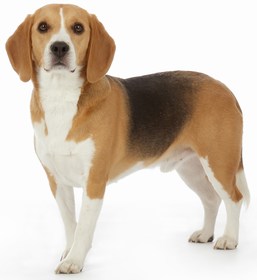 Beagle | 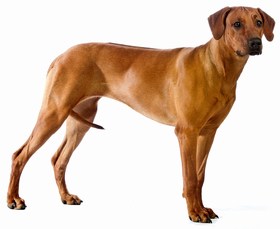 Rhodesian Ridgeback | 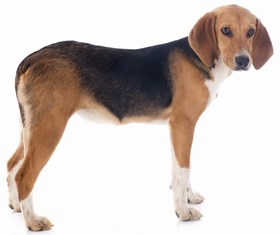 Harrier | 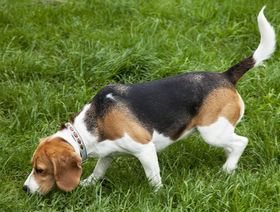 American Foxhound |


